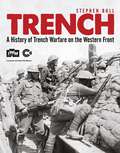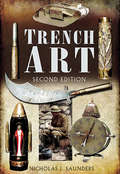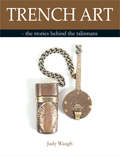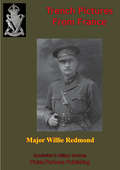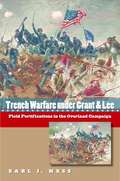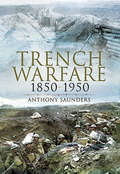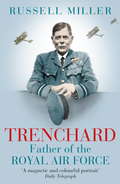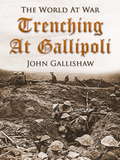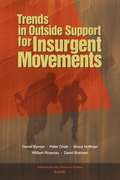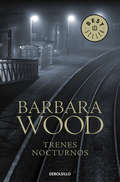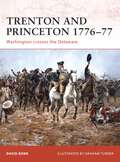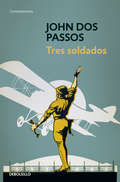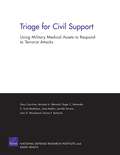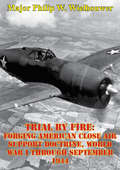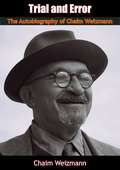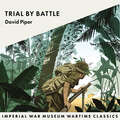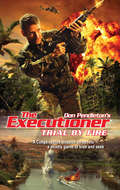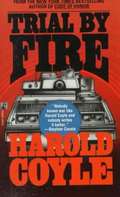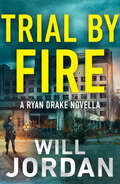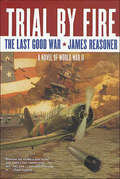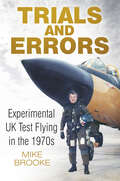- Table View
- List View
Trench
by Stephen Bull'Going up Beek trench on a dark night was no picnic. You started along a long narrow alley winding uphill, your hands feeling the slimy sandbag walls, your feet wary for broken duck boards; now and again a hot, stuff smell, a void space in the wall, and the swish of pumped up water under foot proclaimed the entrance to a mine. ... round corners you dived under narrow tunnels two or three feet high, finally emerging into the comparative open of the front line trench.' Soldier, 1/4th Battalion, Loyal North Lancashire Regiment, 1916In this new book, First World War trench expert Stephen Bull provides a complete picture of trench warfare on the Western Front, from the construction of the trenches and their different types, to the new weaponry and tactics employed in defense and attack. In addition, the book describes the experience of life in the trenches, from length of service, dealing with death and disease, to uniforms and discharge. Alongside his compelling narrative of the campaigns fought in the trenches from 1914 to 1918, annotated trench maps highlight particular features of the trenches, while photographs, documents, and first-hand accounts combine to give a full and richly detailed account of war in the trenches.
Trench Art: A Brief History And Guide, 1914-1939 (Wwi Ser.)
by Nicholas J. SaundersA look at the items crafted by soldiers, prisoners, and civilians from war waste and other items during World War I and the years leading to World War II. Engraved shell-cases, bullet-crucifixes, letter openers and cigarette lighters made of shrapnel and cartridges, miniature airplanes and tanks, talismanic jewelry, embroidery, objects carved from stone, bone and wood—all of these things are trench art, the misleading name given to the dazzling array of objects made from the waste of war, in particular the Great War of 1914-1918 and the inter-war years. And they are now the subject of Nicholas Saunders&’s pioneering study. Saunders reveals the lost world of trench art, for every piece relates to the story of the momentous experience of its maker—whether front-line soldier, prisoner of war, or civilian refugee. The objects resonate with the alternating terror and boredom of war, and those created by the prisoners symbolize their struggle for survival in the camps. Many of these items were poignant souvenirs bought by battlefield pilgrims between 1919 and 1939 and kept brightly polished on mantelpieces, often for a lifetime. Nicholas Saunders investigates their origins and how they were made, exploring their personal meaning and cultural significance. He also offers an important categorization of types which will be a useful guide for collectors.Praise for Trench Art&“The array of art created from a combination of terror and boredom is astonishing. Nicholas writes knowledgeably and movingly on his subjects, and the photos and layout are first class.&” —Steve Earles, Hellbound.ca
Trench Art: the stories behind the talismans
by Judy WaughThis unique collection of trench art evokes emotion. Each piece was created in turmoil but all are beautiful - intuitive works of art about music, faith, love and honour. 56 pieces are from WWI. All are signed with name and service number. Most are small and tactile, often worn as a fob. Many are made from coins and brass from the battlefield; some are carved in bone and wood. Most belonged to young soldiers who were killed in action or died of their wounds - at Gallipoli, France and Flanders, Palestine and Mesopotamia. Twelve belonged to Anzacs. This book tells their stories - of men from England, Scotland, Wales, Australia and New Zealand, bound by adventure and loyalty to their common ancestry. . . . . . The engraved ID holds the key to the story. The heart of each story is different. There are stories of courage under fire and desertions at Colombo; of death from sunstroke and survival through three theatres of war; of medals awarded and fines for misadventures; of men from the Outback in Queensland and young lads from Boys Homes in Kent. There are insights into social history - the ostracism and disgrace of venereal disease, the generational poverty in industrial cities, the imperative to secure oil lines in Iraq. And there are heartbroken letters from those left behind. . . . . . This book will appeal to collectors of artefacts, coins and militaria. It will also appeal to those interested in family history, social history, military history and art therapy in trauma. So much can be found from so little. The range of artefacts may also interest researchers. There are over 64 artefacts in all, including two from the Boer War, one from Crimea, and seven from the convict era - all bearing testament to the primal need to carve a name.
Trench Pictures From France
by Major Willie Redmond"Trench sketches by well-known Irish nationalist MP Major 'Willie' Redmond. A memorial volume published after his death at Messines in June 1917.This is much more than a run-of-the mill account of an officer's life in the trenches of the Great War. The author of these sketches, Major Redmond, (1861-1917) was a well-known moderate Irish nationalist politician... 'Willie' Redmond was himself a nationalist MP, but at the outbreak of the war, although well over military age, he took the view that the war was a fight for all small oppressed nations, and that Irishmen should not stand apart from the struggle. The deaths of women and children in German Zeppelin raids seems to have been the final spur that impelled him to don a British uniform. In his own words 'If the Germans come here ..they will be our masters, and we at their mercy. What that mercy is likely to be, judge by the mercy shown to Belgium'. Redmond helped found the Irish Division and arrived at the front in the winter of 1915. He saw service on the Somme....One of his favourite themes - and the subject of a chapter in this book - was the brotherhood forged in the trenches between the politically divided Protestants of Northern Ireland and his fellow Catholics from the south. Ironically, it was Protestant stretcher-bearers who brought the severely wounded Redmond in from the battlefield of Messines to the dressing station where he died of his wounds in June 1917 at the opening of the successful British offensive. Much mourned by Irish people of all political and religious beliefs, Redmond left a legacy of political tolerance and self-sacrifice. These sketches, first published in the 'Daily Chronicle', cover such subjects as religion in the trenches, the capture of Ginchy on the Somme, No-Man's Land and pets in the trenches...Will interest not only those keen on Great War literature, but also all students of Irish history."-Print ed.
Trench Warfare under Grant and Lee
by Earl J. HessEarl J.Hess's study of armies and fortifications turns to the 1864 Overland Campaign to cover battles from the Wilderness to Cold Harbor. Drawing on meticulous research in primary sources and careful examination of battlefields at the Wilderness, Spotsylvania, North Anna, Bermuda Hundred, and Cold Harbor, , Hess analyzes Union and Confederate movements and tactics and the new way Grant and Lee employed entrenchments in an evolving style of battle. Hess argues that Grant's relentless and pressing attacks kept the armies always within striking distance, compelling soldiers to dig in for protection.
Trench Warfare, 1850–1950: 1850-1950
by Anthony SaundersAlthough many books have been published about the Western Front, few of them look beyond the Great War to consider trench warfare in a wider historical context. Trench warfare was not an aberration of the Western Front. On the contrary, it was a watershed in a greater upheaval in warfare which started in the 1850s and continued well beyond the First World War. This book examines how trench warfare was fought, studying the Crimea, American Civil War and Japanese War 1904-05. He looks at how the Western Front of 1914–18 differed from the trench fighting of the Second World War and the Korean War.The book examines the evolution of trench warfare, technologically and tactically, from the Crimean War to the Korean War, during which time developments in military technology often advanced far beyond tactical thinking. Trench Warfare 1850 1950 discusses the impact of trench warfare on military thinking and considers how the stalemate of the Western Front was overcome. Emergency technologies, from the hand grenade to the tank, are discussed to highlight their impact on trench warfare and, ultimately, on warfare as a whole. Tactically, trench warfare led to the development of the concept of deep battle which was later employed by the Red Army in the Second World War.
Trench Warfare: Contemporary Combat Images from the Great War (The Illustrated War Reports)
by Bob CarruthersThis powerful collection, depicting the grim events of trench warfare, showcases the work of the contemporary combat artists and illustrators from the Great War era. Included here are the works of serious artists, propagandists, illustrators and humorists. The result is a stunning and vivid graphic record of life and death in the trenches during the Great War, as reported to contemporary audiences at a time when the events of the Great War were still unfolding. During the Great War artists and illustrators produced a highly accurate visual record of the fleeting moments the bulky cameras couldnt reproduce. These works form a body ofwar reportage that are as valid as the written word. Today, the work of the combat illustrators and the official war artists from the Great War era is overlooked by historians in favor of photographs, but these illustrations are nonetheless important, as they provide a contemporary record of hand-to-hand fighting, trench raids, aerial dogfights, sea battles, desperate last stands, night actions and cavalry charges.
Trenchard: The Life of Viscount Trenchard, Father of the Royal Air Force
by Russell Miller'A magnetic and colourful portrait' Daily TelegraphHugh 'Boom' Trenchard was embarrassed by being described as 'The Father of the Royal Air Force' - he thought others were more deserving. But the reality was that no man did more to establish the world's first independent air force and ensure its survival in the teeth of fierce opposition from both the Admiralty and the War Office. Born in Taunton in 1873, Trenchard struggled at school, not helped by the shame of his solicitor father's bankruptcy when he was sixteen. He failed entrance examinations to both the Royal Navy and the Army several times, eventually obtaining a commission through the 'back door' of the militia. After service in India, South Africa - where he was seriously wounded - and Nigeria, he found his destiny when he joined the fledgling Royal Flying Corps in 1912, where he was soon known as 'Boom' thanks to his stentorian voice. Quick to recognise the huge potential aircraft offered in future conflicts, he rose rapidly to command the RFC in France during the First World War despite handicaps that would have blighted conventional military careers: he was obstinate, tactless, inarticulate and chronically unable to remember names - yet he was able to inspire unflagging loyalty among all ranks. Despite his conspicuous distrust of politicians, he served as a successful Chief of the Air Staff for a decade after the war and then, at the personal request of the King, took over as Commissioner of the Metropolitan Police, which he reorganised and reformed. He never wavered in his belief that mastery of the air could only be achieved by relentless offensive action, or in his determined advocacy of strategic bombing. His most enduring legacy was the creation of the finest air force in the world, engendered with the spirit that won the Battle of Britain.
Trenchard: The Life of Viscount Trenchard, Father of the Royal Air Force
by Russell Miller'A magnetic and colourful portrait' Daily TelegraphHugh 'Boom' Trenchard was embarrassed by being described as 'The Father of the Royal Air Force' - he thought others were more deserving. But the reality was that no man did more to establish the world's first independent air force and ensure its survival in the teeth of fierce opposition from both the Admiralty and the War Office. Born in Taunton in 1873, Trenchard struggled at school, not helped by the shame of his solicitor father's bankruptcy when he was sixteen. He failed entrance examinations to both the Royal Navy and the Army several times, eventually obtaining a commission through the 'back door' of the militia. After service in India, South Africa - where he was seriously wounded - and Nigeria, he found his destiny when he joined the fledgling Royal Flying Corps in 1912, where he was soon known as 'Boom' thanks to his stentorian voice. Quick to recognise the huge potential aircraft offered in future conflicts, he rose rapidly to command the RFC in France during the First World War despite handicaps that would have blighted conventional military careers: he was obstinate, tactless, inarticulate and chronically unable to remember names - yet he was able to inspire unflagging loyalty among all ranks. Despite his conspicuous distrust of politicians, he served as a successful Chief of the Air Staff for a decade after the war and then, at the personal request of the King, took over as Commissioner of the Metropolitan Police, which he reorganised and reformed. He never wavered in his belief that mastery of the air could only be achieved by relentless offensive action, or in his determined advocacy of strategic bombing. His most enduring legacy was the creation of the finest air force in the world, engendered with the spirit that won the Battle of Britain.
Trenching at Gallipoli: The Personal Narrative Of A Newfoundlander With The Ill-fated Dardanelles Expedition (The World At War)
by John GallishawAlonzo John Gallishaw (St. John's, Newfoundland and Labrador, 1891 - 1968) was a Canadian author and teacher. Galllishaw published five books. The first, Trenching at Gallipoli is subtitled A Personal Narrative of a Newfoundlander with the Ill-fated Dardanelles Expedition and was dedicated to Professor Charles Townshend Copeland. His second book, The Man in the Ranks is the tale of a soldier and was written in collaboration with William Lynch. (Excerpt from Wikipedia)
Trends in Outside Support for Insurgent Movements
by Bruce Hoffman Peter Chalk Daniel Byman William Rosenau David BrannanThe most useful forms of outside support for an insurgent movement include safe havens, financial support, political backing, and direct military assistance. Because states are able to provide all of these types of assistance, their support has had a profound impact on the effectiveness of many rebel movements since the end of the Cold War. However, state support is no longer the only, or indeed necessarily the most important, game in town. Diasporas have played a particularly important role in sustaining several strong insurgencies. More rarely, refugees, guerrilla groups, or other types of non-state supporters play a significant role in creating or sustaining an insurgency, offering fighters, training, or other forms of assistance. This report assesses post-Cold War trends in external support for insurgent movements. It describes the frequency that states, diasporas, refugees, and other non-state actors back guerrilla movements. It also assesses the motivations of these actors and which types of support matter most. This book concludes by assessing the implications for analysts of insurgent movements.
Trends in Russia's Armed Forces: An Overview of Budgets and Capabilities
by Olga Oliker Keith Crane Brian NichiporukThe authors assess how Russian military forces are postured and resourced and how they are likely to operate. They also discuss the goals and effects of Russian military reform efforts, including initiatives that span all of the Russian armed forces’ services and independent branches. Touching on most of Russia’s armed forces’ major capabilities, the authors conclude with a look at how those capabilities are being integrated in practice.
Trenes nocturnos (Bestseller Oro Ser.)
by Barbara WoodTrenes oscuros que pasan por la ciudad polaca de Sofía, conducen a una oscuridad aún mayor: van a Auschwitz. Algunos en Sofía lo saben: el doctor Jan Szukalski y su ayudante, la doctora Maria Duszynska, el joven soldado Hans Kepler, incapaz de soportar su «trabajo» en el campo de la muerte, los guerrilleros que actúan en los alrededores de la ciudad... Poco pueden hacer, pero lo intentan. Jan y Maria lo harán de la forma más original, provocando una falsa epidemia de tifus que aleje a los alemanes. Aunque engañarlos y ocultar el secreto de la conspiración no será nada fácil... Trenes nocturnos es una historia de heroísmos ocultos, de conductas humanas conducidas hasta los límites de su grandeza o su abyección, de amores que fructifican o se desgarran. Una obra que puede leerse como una apasionante novela de sentimientos, pero también como una apología del ser humano, capaz también de lo sublime, como un recordatorio de los horrores de la ocupación y, sobre todo, una llamada a la esperanza.
Trenton and Princeton 1776-77
by David Bonk Graham TurnerFollowing the battle of White River and the fall of Forts Washington and Lee during the American Revolutionary War (1775-1783), George Washington withdrew his army, crossing the Delaware River to regroup. However, with morale at a critical low and the terms of enlistment of many of his troops set to expire, Washington decided on one more strike before the winter weather made military operations impossible. Re-crossing the Delaware on Christmas night, 1776, Washington's army surprised the Hessian garrison at Trenton and managed to kill, wound or capture 1,000 of the enemy for the loss of only four men. Then, avoiding a major engagement with the British Army under General Cornwallis that had been sent to track him down, Washington attacked and defeated another small British force at Princeton. Having inflicted two costly and embarrassing defeats on the British forces, Washington withdrew his army into winter quarters at Morristown. Using a combination of modern photographs and period artwork, this book tells the story of the legendary campaign that restored the morale of American forces, caused the British to abandon large parts of New Jersey, and established General George Washington's reputation as a daring military strategist.
Tres soldados
by John Dos PassosTres soldados es una novela que critica aceradamente el militarismo y retrata a la generación de jóvenes estadounidenses que, como el propio autor, participaron en la Primera Guerra Mundial y vieron pisoteados sus sueños. Los tres protagonistas #Dan Fuselli, Chris Chrisfield y John Andrews# tratan de mantener la cordura y su individualidad en un mundo que los esclaviza física y moralmente. En esta novela, John Dos Passos explora los mecanismos del miedo, la rebeldía y los efectos deshumanizadores de la maquinaria de guerra.«Hasta que Tres soldados caiga en el olvido y la fabulación alcance la inevitable victoria sobre los hechos, ninguna historia de guerra escrita en Estados Unidos podrá soportar que la comparen con ella, y ninguna historia que sea menos meticulosamente verdadera la superará.»H. L. Mencken
Triage for Civil Support: Using Military Medical Assets to Respond to Terrorist Attacks
by K. Scott Mcmahon Jesse D. Malkin Roger C. Molander Gary Cecchine Michael A. WermuthEven before September 11, 2001, threat assessments suggested that the United States should prepare to respond to terrorist attacks inside its borders. This monograph examines the use of military medical assets to support civil authorities in the aftermath of a chemical, biological, radiological, nuclear, or conventional high explosives attack inside the United States. The authors focus on key questions, including under what circumstances military medical assets could be requested and what assets are likely to be requested.
Trial By Fire: Forging American Close Air Support Doctrine, World War I Through September 1944
by Major Philip W. WielhouwerProper doctrine for close support of American ground forces by airpower has been a tumultuous issue since the first days of combat aircraft. Air and ground leaders struggled with interservice rivalry, parochialism, employment paradigms, and technological roadblocks while seeking the optimum balance of missions given the unique speed, range, and flexibility of aircraft. Neither ground force concepts of airpower as self-defense and extended organic artillery, nor air force theories focused on command of the air and strategic attack fit the middle ground of close air support (CAS), leaving a doctrinal void prior to American combat in World War II. This thesis focuses on the critical period from September 1939 through the doctrinal and practical crucible of North Africa, which eventually produced a resoundingly successful system. Theoretical and practical changes in organization and command, airpower roles, and the tactical air control system are examined, with subarea focus on cooperation and communications technology. Upon examination, discerning leadership, able to transcend earlier compromises and failures, emerges as the essential element for CAS success during the war. While many airpower concepts proved valid, air-ground cooperation through liaison proved indispensable, a lesson repeated even today.
Trial and Error: The Autobiography of Chaim Weizmann
by Chaim WeizmannThis is the highly personal story of a Jew from Motol in the province of Minsk, one of the darkest corners in Russia’s Pale of Settlement, who became the trusted friend of the world’s great statesmen, a gifted scientist of international reputation, the leader of his people-and one of the great democratic leaders of all time. A maker of history who shaped not only Jewish history but that of England and its empire at a crucial moment in its existence, his is the story of international politics over the past three or four decades. Aware of the difficulty of reconciling a Jewish National Home with the necessities of imperial politics, he discusses not only the present-day situation in Palestine, with its tensions, explosive passions and fierce rivalries, but the whole problem of the Middle East as it is bound up with the fortune of the world’s great nations.A man of great humor and humanity, a man of faith with an abhorrence of violence and a passion for justice, for more than thirty years the undisputed leader of world Zionism, he describes with intimate knowledge the growth of that movement, its battles and triumphs, its internal conflicts, its personalities, what the Jews have already done in Palestine and their almost Messianic dreams for the future. He retraces the long hard road that led to the triumph of the Balfour Declaration; tells the story of disillusionment under the British Mandate; of the colonization of Palestine in the face of fearful odds; of the riots, the White Papers, the unspeakable horrors of World War II; discusses the pros and cons of partition and the whole dynamite-laden question of Arab-Jewish relations.Sincere and candid, informed with a deep wisdom, spiced with humor, wit and irony—and occasionally anger—this book will rank unquestionably with the great autobiographies of any period.Book One covers the years 1874-1917 and Book Two covers the years 1918-1948.
Trial by Battle: Imperial War Museum Wartime Classics
by David PiperOctober 1941. Twenty-one-year-old Alan Mart is posted to India and taken under the wing of the dogmatic, overbearing Acting-Captain Sam Holl. Following the Japanese advance on Singapore, the men are deployed to Malaya. What follows is a quietly shattering and searingly authentic depiction of the claustrophobia of jungle warfare and the indiscriminate nature of conflict.Based on David Piper's own wartime experience in South East Asia, this new edition of a 1959 classic includes a contextual introduction from IWM which sheds new light on the dramatic true events that so influenced its author.(P)2019 Headline Publishing Group Ltd
Trial by Fire
by Don PendletonWhen a plane filled with American cadets is shot down in the Democratic Republic of the Congo, Mack Bolan is sent to find the group. But he isn't the only one looking for them--terrorists are tracking them through the jungle, too. Original.
Trial by Fire
by Harold CoyleEnjoying a brief period of peace, the United States is caught by surprise when a government overthrow in Mexico suddenly destabilizes the two countries almost 2,000 mile long undefended border..Diplomatic negotiations begin, but a series of savage cross border attacks on civilians compels the U. S. to mobilize its armed forces, invade Mexico and establish a security zone. While politicians and the people debate the controversial invasion, the United States Army must win quickly what could deteriorate into a long, bloody war.
Trial by Fire (Ryan Drake)
by Will JordanA CIA agent must go into Ukraine to find a compromised source in this international thriller novella. Tech specialist Keira Frost has just graduated to the big leagues. But despite numerous commendations for outstanding achievement and a tour of duty under her belt, it&’s her reputation for insubordination that precedes her. Tasked with proving she can take orders with Agency field ops, Keira is eager to get started. But her new CO Ryan Drake is not going to make it easy. As the team is sent to the wasteland of Pripyat, the town devastated by the disaster of Chernobyl, radiation is far from the only danger waiting for them . . .
Trial by Fire: A Novel (P. T. Deutermann WWII Novels)
by P. T. DeutermannBased on a true story—P. T. Deutermann's Trial by Fire is a dramatic WWII novel of attack, survival, and triumph on board an aircraft carrier in the Pacific.It's March 1945 and the war in the Pacific is approaching its apocalyptic climax. The largest wartime armada ever assembled, Task Force 58, is closing in on Okinawa; once taken, it will finally put American B-29 bombers in comfortable range of the home islands of Japan—and victory.At the heart of the fleet are 14 Essex-class aircraft carriers, including the USS Franklin, known as "Big Ben"—a 27,000-ton behemoth, home to 3,600 crewmen and 100 aircraft. Just after dawn, while crewmen prepare for battle, a single Japanese Yokosuka D4Y bomber breaks through the clouds and drops a 500-pound semi-armor piercing bomb on Big Ben. The bomb rips through the wooden flight deck before exploding on the hangar deck, amidst two dozen fully fueled and armed fighter-bombers. The resulting explosion engulfs both the hangar deck and all the planes spotted on the flight deck. Bombs cook off and rockets howl in all directions, both on the flight deck and down in the hangar bays. Hundreds of men are forced to leap into the sea to escape the rivers of burning aviation gasoline, leaving the captain with only one third of his crew, of whom there are more dead, wounded and trapped men left onboard than able-bodied sailors.Trial By Fire is the gripping novelization of how, against all odds, the sailors of the Franklin were able to save their ship, after 3 agonizing days of battling the flames that ultimately claimed the lives of 832 men and injured 300 more. Readers will be astounded and humbled by the heroic actions of a few extraordinarily brave sailors in the face of unending catastrophe.
Trial by Fire: The Last Good War (Last Good War Ser. #2)
by James ReasonerDecember 7, 1941"A day that will live in infamy," is how President Franklin Delano Roosevelt described the Japanese attack on Pearl Harbor. With a devastating stroke, World War II was no longer a strictly European war; it was now our war, too. In this powerful, exciting sequel to Battle Lines, James Reasoner shows us the fight through four friends cast into the chaos of the war that reshaped the twentieth century.As the Japanese attack Pearl Harbor, they simultaneously launch an assault on Wake Island, where Adam Bergman is one of the marines working feverishly to complete the installation of an airstrip. He is unaware of the Pearl Harbor disaster that sends hundreds of casualties streaming into the hospital on the United States Naval Base, where his wife, Nurse Catherine Tancred of the Naval Medical Corps, is one of dozens ministering to the wounded and dying.While Adam and Catherine are immersed in the Pacific war effort, their friends Joe and Dale Parker are stationed with British tank divisions that are fighting the Germans for control of North Africa.Joe and Dale are only supposed to advise their British allies, but before long, Dale is manning a tank to help stem the tide of battle, and Joe is working directly with British intelligence in Cairo.Upon entering World War II, Americans fought to defend freedom around the world. Through the eyes of those in battle, we share their struggles and hardships in this memorable story of Americans at war.At the Publisher's request, this title is being sold without Digital Rights Management Software (DRM) applied.
Trials and Errors: Experimental UK Test Flying in the 1970s
by Mike BrookeMike Brooke's successful RAF career had taken him from Cold War Canberra pilot to flying instructor at the Central Flying School in the 1970s. For his next step he undertook the demanding training regime at the UK’s Empire Test Pilots’ School. His goal: to become a fully qualified experimental test pilot. Trials and Errors follows his personal journey during five years of experimental test flying, during which he flew a wide variety of aircraft for research and development trials. Mike then returned to ETPS to teach pilots from all over the world to become test pilots. In this, the sequel to his successful debut book A Bucket of Sunshine and its follow-up Follow Me Through, he continues to use his personal experiences to reveal insights into trials of the times, successes and failures. Trials and Errors will prove fascinating reading for any aviation enthusiast.
